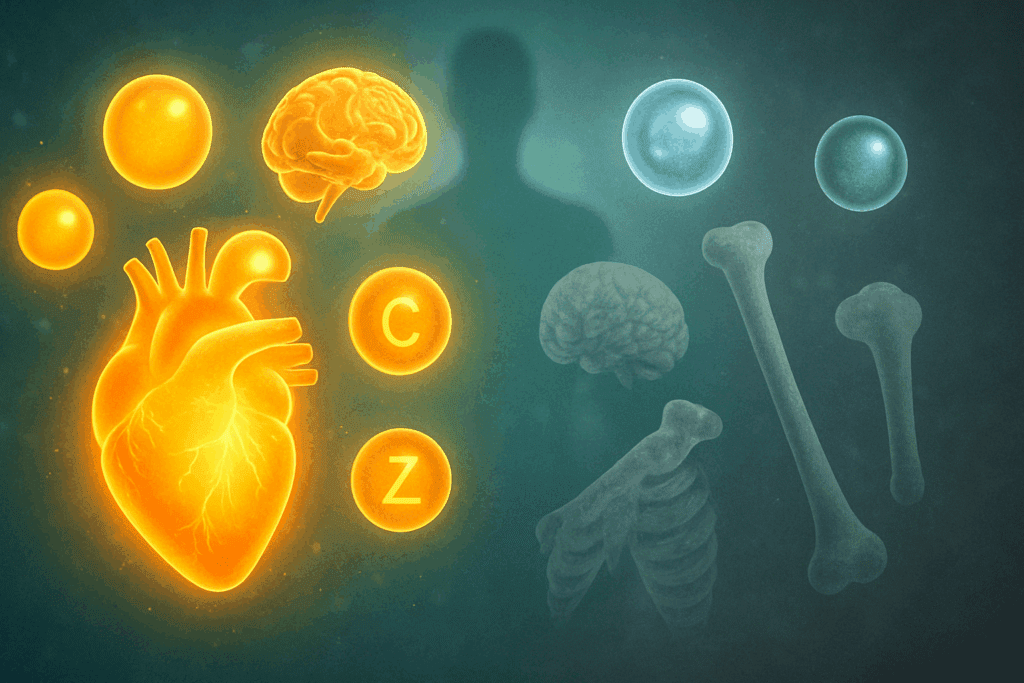Understanding what are micronutrients and why they play a central role in human health is essential for anyone aiming to maintain wellness through diet. Though often overshadowed by macronutrients such as proteins, fats, and carbohydrates, micronutrients are no less crucial. They are required in smaller amounts, yet their impact on bodily functions is substantial, spanning immune support, bone health, cognitive performance, and cellular integrity. In this guide, we will explore the definition of micronutrients in food and nutrition, offer real-world micronutrients examples, and provide clarity around common phrases like “micronutrients definition” and “what is micronutrients specifically,” ensuring scientific accuracy and practical relevance throughout.
You may also like: Macronutrients vs Micronutrients: What the Simple Definition of Macronutrients Reveals About Your Diet and Health
Defining Micronutrients and Their Role in Nutrition
The question of what the simple definition of micronutrients is can be answered clearly: micronutrients are vitamins and minerals that the body requires in trace amounts for proper physiological function. They do not provide energy themselves but are indispensable for the metabolism of energy-yielding macronutrients. The term encompasses essential elements such as vitamin A, iron, zinc, and iodine, which must be obtained from dietary sources, as the human body cannot produce them in sufficient quantities on its own.
When professionals define micronutrients, they often group them into two primary categories: vitamins and minerals. Vitamins are organic compounds that assist in various metabolic processes, while minerals are inorganic elements crucial for structural and enzymatic functions. Understanding this micronutrients definition allows us to appreciate their subtle yet powerful role in maintaining homeostasis. For example, even a mild deficiency in vitamin D can lead to impaired calcium absorption and weakened bones, illustrating that the impact of micronutrients can be both profound and far-reaching.

Micronutrients Examples in Everyday Food Choices
To bring these ideas into focus, consider everyday micronutrients examples. Leafy greens like spinach and kale are rich in folate, a B-vitamin vital for DNA synthesis and repair. Citrus fruits provide a potent dose of vitamin C, known for enhancing immune defense and supporting collagen production. Dairy products offer calcium, essential for bone integrity and muscle function, while seafood is a reliable source of iodine and selenium, which regulate thyroid function and protect against oxidative stress.
These examples are not merely academic; they reflect how micronutrients and micronutrients-rich foods are foundational to health. In cooking practices, micronutrient retention is influenced by preparation methods. For instance, the sentence of micronutrient in nutrition becomes relevant when we consider how boiling vegetables can cause water-soluble vitamins like B-complex and C to leach into cooking water. This underscores the importance of both food selection and preparation techniques in optimizing nutrient intake.
The Scientific Basis of Micronutrient Needs
Micronutrient requirements vary according to age, sex, life stage, and health status. Children, pregnant women, and older adults often have increased needs for specific nutrients. This variability illustrates why a universal approach to nutrition is inadequate and emphasizes the need for personalized dietary planning. The Recommended Dietary Allowances (RDAs) established by health authorities offer guidance on the daily intake levels of specific vitamins and minerals to prevent deficiencies and maintain optimal health.
When asking what is micronutrients specifically, the answer must acknowledge their bioavailability—the degree to which a nutrient is absorbed and utilized by the body. Bioavailability is influenced by factors such as nutrient form, presence of inhibitors (like phytates and oxalates), and interactions with other nutrients. For instance, iron from animal sources (heme iron) is more readily absorbed than plant-based (non-heme) iron, and vitamin C can enhance iron absorption from plant sources. Recognizing these interactions adds depth to the micronutrient definition and shows how real-world dietary habits affect nutrient status.

Micronutrients and Disease Prevention
The prevention of chronic disease is one of the most compelling arguments for understanding which were micronutrients that contribute to long-term health. A well-balanced micronutrient profile has been linked to reduced risk of cardiovascular disease, cancer, cognitive decline, and osteoporosis. Antioxidant nutrients such as vitamins C and E, along with minerals like selenium and zinc, play protective roles by neutralizing free radicals and reducing oxidative stress—a key contributor to cellular aging and disease development.
For instance, folate deficiency during early pregnancy is associated with neural tube defects in the fetus, highlighting the importance of adequate micronutrient intake during critical developmental windows. Likewise, insufficient vitamin B12 and iron levels can contribute to anemia, affecting energy levels, cognitive performance, and immune competence. These examples emphasize that when we define micronutrients, we are not merely identifying chemical compounds—we are recognizing essential agents in the preservation of health and prevention of disease.

Micronutrient Deficiencies and Their Impact on Public Health
Micronutrient deficiencies are often referred to as “hidden hunger” because they may not immediately manifest in overt symptoms but can have significant long-term consequences. Iron deficiency anemia is among the most widespread micronutrient-related conditions globally, particularly affecting women and children in low-resource settings. Vitamin A deficiency, another major public health concern, impairs vision and increases susceptibility to infections, especially in children.
Understanding the sentence of micronutrient in nutrition involves recognizing how these deficiencies impact various systems. Zinc deficiency, for example, compromises immune response and wound healing. Inadequate iodine intake leads to goiter and developmental delays, particularly affecting populations in areas with iodine-depleted soils. Addressing these deficiencies requires not only awareness but also targeted public health interventions, such as food fortification, supplementation, and dietary diversification.

The Connection Between Cooking and Micronutrient Preservation
The term micronutrient definition cooking gains importance when we consider how food preparation methods influence nutrient retention. Cooking methods such as boiling, steaming, roasting, and microwaving each affect micronutrients differently. For example, while steaming preserves water-soluble vitamins better than boiling, roasting vegetables may degrade some heat-sensitive nutrients but enhance the bioavailability of others, such as lycopene in tomatoes.
In practical terms, this knowledge empowers individuals to make informed culinary choices that protect the integrity of their meals. For instance, lightly steaming broccoli instead of boiling it can help preserve vitamin C and folate content. Understanding the impact of cooking on nutrients transforms the act of meal preparation from a mere culinary task to a strategic tool in nutritional optimization. This bridges the gap between scientific understanding and everyday decision-making in the kitchen.
Micronutrients and Modern Diets: Hidden Risks in Western Patterns
The modern Western diet, characterized by high intake of ultra-processed foods and low consumption of fruits, vegetables, and whole grains, poses significant risks for micronutrient insufficiency. While calorie intake may be sufficient—or even excessive—micronutrient density is often lacking. This phenomenon is termed “empty calories,” referring to foods that provide energy but few or no vitamins and minerals.
This pattern is particularly concerning in the context of the rising prevalence of non-communicable diseases such as obesity, diabetes, and cardiovascular disorders. These conditions are not merely the result of macronutrient imbalances but are also driven by inadequate intake of protective micronutrients. Thus, addressing the micronutrients definition in the modern context involves reevaluating not only what we eat but also how food systems are structured, marketed, and consumed.

The Importance of Micronutrients in Life Stages
Different stages of life impose distinct micronutrient requirements. Infants and children need adequate levels of calcium, vitamin D, and iron for skeletal development and cognitive growth. Adolescents experience rapid physiological changes that increase demands for zinc, folate, and B-vitamins. During pregnancy and lactation, women require enhanced levels of iron, iodine, and folic acid to support fetal development and maternal health.
In later life, aging bodies become less efficient at absorbing certain nutrients, such as vitamin B12 and calcium, necessitating adjusted intake strategies. These changing requirements reflect the adaptive nature of nutrition across the lifespan. Understanding what are micronutrients in the context of life stages highlights the dynamic relationship between diet and human development, reinforcing the value of dietary education and proactive health management.
Micronutrient Supplementation: When and Why It’s Needed
Although a diverse diet remains the gold standard for obtaining nutrients, supplementation may be necessary in specific scenarios. Individuals with medical conditions that impair nutrient absorption—such as celiac disease, inflammatory bowel disease, or those undergoing bariatric surgery—often require tailored micronutrient support. Similarly, people on restrictive diets, including vegans and vegetarians, may need supplementation for nutrients such as vitamin B12, iron, and zinc.
Pregnant women are routinely advised to take prenatal vitamins that include folic acid, iron, and iodine to meet increased demands. Older adults may benefit from vitamin D and B12 supplements due to decreased synthesis and absorption with age. However, indiscriminate supplementation can lead to toxicity or nutrient imbalances. Therefore, healthcare providers must assess individual needs based on evidence, ensuring that interventions are safe, appropriate, and effective.

Nutrigenomics: The Future of Micronutrient Personalization
The emerging field of nutrigenomics—the study of how genes interact with nutrients—has opened new frontiers in understanding the role of micronutrients in personalized health strategies. Genetic variations can affect how individuals metabolize and utilize specific nutrients. For example, a mutation in the MTHFR gene may impair folate metabolism, requiring affected individuals to consume the bioactive form of folate (methylfolate) instead of folic acid.
Such insights make the question of what is micronutrients specifically even more relevant, as it moves the conversation from generalized recommendations to individualized nutrition plans. As science progresses, healthcare professionals will increasingly use genetic profiles to guide dietary choices and supplement prescriptions. This transformation underscores the importance of ongoing education and adaptability in clinical nutrition practice.
How to Improve Micronutrient Intake Through Diet
Improving micronutrient intake begins with food quality and diversity. Emphasizing whole, minimally processed foods rich in color, texture, and variety ensures a broader range of nutrients. Incorporating dark leafy greens, colorful vegetables, legumes, nuts, seeds, dairy products, eggs, lean meats, and seafood creates a nutrient-dense diet that meets most vitamin and mineral needs.
Practicing mindful cooking methods and seasonal eating further enhances micronutrient availability. Rotating food sources and being conscious of soil quality and farming methods also matter, as modern agricultural practices can deplete soil of essential trace minerals. Education and access remain critical pillars, as even the most nutrient-rich food cannot benefit those who are unaware of its value or unable to afford it. In this context, community programs and public health initiatives play a vital role in promoting dietary equity.
Understanding Micronutrients and Micronutrients in Holistic Wellness
Micronutrients and micronutrients-related education are at the core of any serious wellness strategy. They connect the microscopic with the macroscopic, affecting everything from hormonal balance and cognitive clarity to muscular function and immunity. Yet, their importance is often misunderstood or underappreciated in mainstream conversations around health and fitness.
A deeper appreciation for the sentence of micronutrient in nutrition reveals how each nutrient works in synergy with others, shaping health outcomes in profound ways. For instance, vitamin D’s role in calcium metabolism is closely tied to magnesium status, illustrating the importance of viewing nutrients not in isolation, but as part of a broader nutritional ecosystem. When clinicians and patients alike understand this interconnectedness, the potential for health optimization expands significantly.
Micronutrient Literacy as a Public Health Imperative
Promoting micronutrient literacy must become a public health priority. This involves integrating accurate, accessible information into schools, clinics, media, and community programs. Many dietary challenges stem not from lack of food, but from lack of knowledge about what the food provides. Equipping individuals with the tools to define micronutrients, identify micronutrients examples, and understand the definition of micronutrients in food allows for more informed choices and improved long-term outcomes.
Incorporating nutrition labels that highlight not just macronutrient content but also micronutrient density, improving food fortification strategies, and enhancing the availability of whole foods in underserved areas are essential components of this strategy. Ultimately, empowering individuals to know what is micronutrients specifically, and why that knowledge matters, fosters resilience against both disease and misinformation.
Frequently Asked Questions (FAQ): Micronutrients in Food and Nutrition
1. How do micronutrient needs change in high-performance athletes compared to the general population? Micronutrient requirements for high-performance athletes differ significantly from those of the general population. While the simple definition of micronutrients refers to essential vitamins and minerals needed in small amounts, athletes often require higher levels due to increased metabolic demands and physical stress. For example, B-complex vitamins are crucial for energy metabolism, and iron is vital for oxygen transport, both of which are taxed heavily during intense training. Athletes may also experience greater micronutrient loss through sweat, particularly sodium, potassium, and magnesium, necessitating more strategic replenishment. Understanding what is micronutrients specifically for athletic performance can help optimize endurance, reduce fatigue, and support faster recovery.
2. What role do micronutrients play in managing stress and mental health? Micronutrients and micronutrients balance play a vital but often overlooked role in psychological well-being. Emerging research shows that deficiencies in specific micronutrients like magnesium, zinc, and vitamin B6 can negatively impact neurotransmitter synthesis, which influences mood and cognitive resilience. While people may often focus on macronutrients for energy, understanding the micronutrients definition within mental health is essential. For instance, zinc has been linked to serotonin regulation, and magnesium has a calming effect on the nervous system. In high-stress lifestyles, ensuring adequate intake of these micronutrients examples through diet or supplementation can be a foundational part of mental health strategies.
3. How can urban soil depletion impact the micronutrient content of plant-based foods? Few people realize that the definition of micronutrients food quality can vary drastically depending on environmental conditions, especially soil quality. As urban agriculture and large-scale farming become more common, soil depletion has led to a measurable decline in the micronutrient density of crops. This means that vegetables grown in nutrient-poor soil may contain lower levels of iron, magnesium, or selenium, even if they appear fresh and vibrant. When we define micronutrients in the context of food systems, it’s critical to consider agricultural practices. Rotating crops, using organic compost, and practicing regenerative farming are all methods that can help restore micronutrient content in the food we consume.
4. Are micronutrients involved in epigenetic regulation, and if so, how? Yes, micronutrients are increasingly recognized for their role in epigenetics—the study of how gene expression is modified without changing the DNA sequence. Nutrients like folate, choline, and vitamin B12 serve as methyl donors in one-carbon metabolism, which directly influences DNA methylation patterns. This complex process can affect everything from fetal development to disease susceptibility later in life. When we ask what is micronutrients specifically in cellular signaling, epigenetic modulation is a key answer. These interactions highlight that micronutrients and micronutrients-based diets are not only about meeting daily needs but also about influencing long-term health outcomes through gene-nutrient interaction.
5. How do food processing and packaging affect micronutrient levels? Micronutrient degradation is a serious consequence of modern food processing, which includes refining, heating, and long-term storage. The micronutrient definition cooking context expands here to reveal that water-soluble vitamins like B1, B2, and C are especially vulnerable to heat and oxidation. Furthermore, some minerals may leach into packaging materials or degrade during exposure to light and air. This is why whole, minimally processed foods tend to be more reliable sources when discussing what the simple definition of micronutrients implies for health. Choosing fresh or frozen produce over canned, and preparing meals at home, can help preserve vital nutrients that support immunity, energy, and metabolism.
6. Can micronutrients impact how medications work in the body? Absolutely. Drug-nutrient interactions are a critical aspect of clinical nutrition, often underrecognized in routine care. Certain medications can deplete key micronutrients—like how proton pump inhibitors reduce magnesium and B12 absorption or how diuretics can lower potassium and zinc levels. In such cases, understanding which were micronutrients affected is vital for avoiding unintended deficiencies. Conversely, excess intake of specific nutrients can also interfere with drug efficacy, as seen with high doses of vitamin K reducing warfarin effectiveness. The ability to define micronutrients in the context of pharmacology is crucial for integrated, safe treatment plans.
7. What innovations are emerging in biofortification to improve global micronutrient access? Biofortification is an exciting frontier in addressing widespread nutrient deficiencies, especially in underserved regions. This agricultural innovation enhances the micronutrient profile of staple crops through selective breeding or genetic engineering. For instance, golden rice has been developed to contain beta-carotene, a precursor to vitamin A. This method aligns with public health efforts to improve the definition of micronutrients food access, particularly in populations where diversity in diet is limited. It represents a scalable, sustainable solution to combating deficiencies where conventional supplementation programs may be impractical.
8. How do cultural dietary patterns affect micronutrient intake across the globe? Cultural habits profoundly influence micronutrient consumption and can explain regional disparities in nutrient-related diseases. In Mediterranean diets, for example, the liberal use of olive oil, vegetables, and legumes supports a diverse intake of micronutrients, whereas traditional Asian diets often emphasize fermented foods and seaweed, rich in B-vitamins and iodine. When exploring what are micronutrients in a global health context, it’s important to evaluate traditional eating patterns and how modernization may disrupt them. Westernized diets often displace nutrient-dense native foods with processed alternatives, leading to a drop in key micronutrients examples and a rise in preventable health issues.
9. Are there signs that indicate a person may not be absorbing micronutrients properly even with a balanced diet? Yes, even individuals with a seemingly healthy diet can experience malabsorption issues due to conditions like celiac disease, Crohn’s disease, or even chronic stress, which alters gut permeability. Subtle signs such as persistent fatigue, brittle nails, or frequent infections might point to hidden deficiencies. Understanding the sentence of micronutrient in nutrition includes recognizing these physiological red flags that something deeper may be amiss. In such cases, functional lab testing can assess actual nutrient levels rather than relying solely on dietary intake. This bridges the gap between theory and practice in micronutrients definition and ensures more effective nutrition strategies.
10. What is the future of personalized nutrition in optimizing micronutrient intake? The future of personalized nutrition is being shaped by rapid advances in genomics, microbiome research, and digital health tracking. These tools allow practitioners to tailor micronutrient recommendations based on individual genetics, gut flora, and metabolic biomarkers. No longer do we rely solely on generalized RDAs; now, we can define micronutrients needs more precisely. Apps and wearables that track dietary intake and integrate blood data are increasingly used to close the gap between dietary advice and real-time health metrics. As we refine our understanding of what is micronutrients specifically for each unique body, the promise of optimizing wellness through micronutrients and micronutrients-based personalization becomes more achievable than ever.
Why Micronutrients Matter More Than Ever in Modern Nutrition
In our current nutritional landscape—shaped by fast-paced lifestyles, industrial food systems, and complex health demands—the question of what are micronutrients is more pressing than ever. Understanding the definition of micronutrients food reveals not only the foundation of human biology but also a blueprint for preventing disease, promoting longevity, and enhancing quality of life. As science evolves and our knowledge deepens, the importance of knowing which were micronutrients responsible for optimal health becomes more than an academic pursuit—it becomes a public imperative.
Through the lens of experience, expertise, authoritativeness, and trustworthiness, this guide emphasizes that micronutrients are not optional extras but essential components of a well-functioning human body. From the kitchen to the clinic, and from policy to personal choice, the ability to define micronutrients clearly and act on that knowledge has the power to transform individual lives and collective health outcomes for the better.
Further Reading:
How much micronutrients should people be consuming?
A Review of Micronutrients and the Immune System–Working in Harmony to Reduce the Risk of Infection


